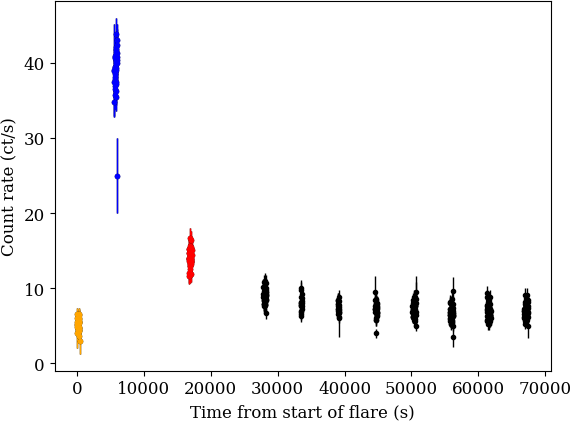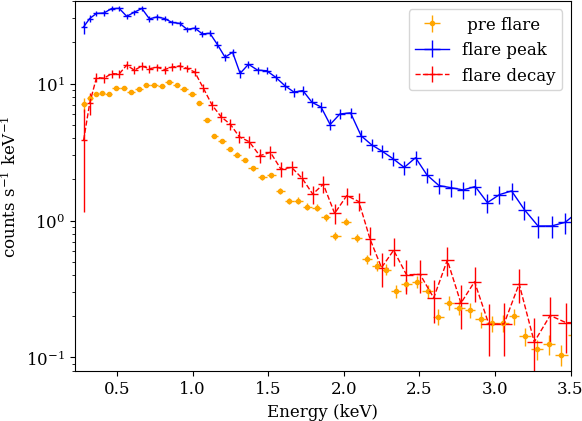NICER / ISS Science Nugget
for September 28, 2023
A Superflare in a Planet-hosting Young Solar Analogue
Some 144 lightyears away, toward the Toucan constellation in Earth's southern skies, lies a pair of stars similar to our Sun but much younger. The primary and secondary stars (A and B) of the DS Tucanae binary are estimated to be 45 million years old, just 1% the age of our solar system, but are comparable in mass to our Sun. Star A, the more luminous one, is known to be magnetically active, producing energetic flares as often as twice per day. It also hosts a gas-giant planet similar to Neptune, in a close-in (8-day period) orbit. This combination of properties makes DS Tuc A an important example of a young solar analogue (YSA), a category of stars that promises to inform our understanding of the conditions under which life in our solar system may have originated, addressing the question: "How do frequent stellar flares affect the emergence of life on planets around active stars?"
The Sellers Exoplanet Environments Collaboration (SEEC), named after the late astronaut and scientist Piers Sellers, aims to answer such questions, using (among other tools) NICER observations to characterize the energy and particle-radiation content of energetic flares in nearby planet-hosting stars, especially those comparable to the young Sun. As part of these ongoing efforts, NICER observed DS Tuc on 49 occasions between October 2022 and July 2023. A report recently accepted for publication as a Research Note of the American Astronomical Society described a flare observed by NICER on 30 April, 2023. Led by graduate student and NICER/GSFC summer intern M. G. Dethero, the team used NICER spectroscopic data to track the evolving temperature of the plasma erupting from the star's photosphere, which peaked at 44 million Kelvin and produced a magnetic loop comparable in size to the radius of the star itself. The flare's total energy output in X-rays was estimated at 2.8 x 1027 Joules, one of the highest seen from this system and placing it in the "superflare" category. NICER and SEEC continue to study similar events to characterize the environments of extrasolar planets, to assess their habitability, and to gain insight into the early history of our own home planet's ability to foster and support life.


Left: X-ray brightness, in detected photons per second averaged over 10-second intervals, of the DS Tuc system as measured by NICER on 30 April, 2023. Colors are used to represent the pre-flare (orange), flare peak (blue), and flare decay (red) intervals. The characteristic decay timescale is estimated to be approximately 4900 seconds, slightly shorter than the ISS orbital period.
Right: X-ray energy spectra for the three flare phases, with the same color coding as in the Figure on the right. The magnitudes, slopes, and "wiggles" in each spectrum are modeled to infer plasma temperatures and elemental abundances as a function of time across the flare.
<< Previous
Main Index